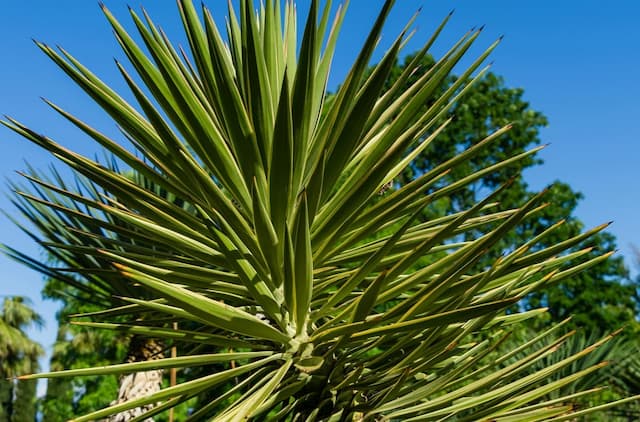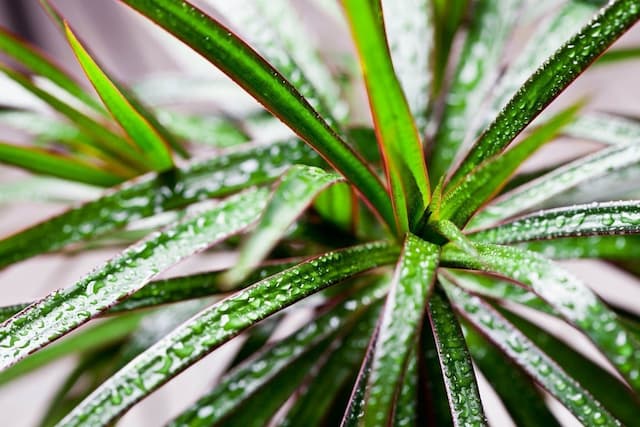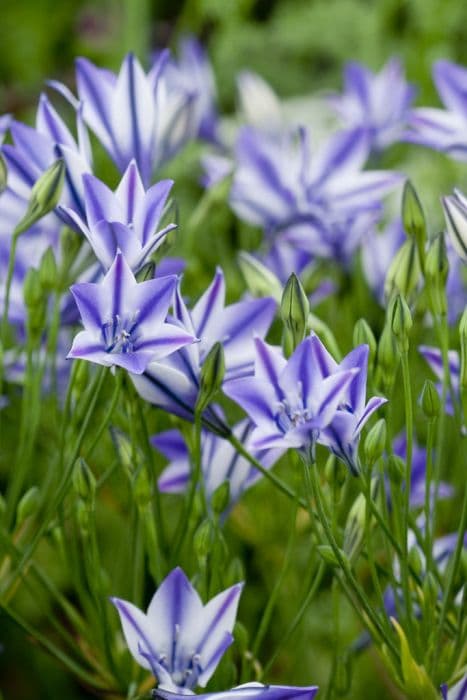Century Plant Agave americana

ABOUT
The Agave americana, commonly known as the century plant, has a dramatic and imposing presence. This plant is easily recognized by its large rosette of fleshy, thick leaves. These leaves are gray-green in color and have a linear-lanceolate shape, being long, pointed and arching gracefully from the base of the plant. The margins of the leaves are often lined with sharp teeth, and a particularly sturdy, pointed tip can be found at the end of each leaf, which can be dangerous if not handled carefully. The texture of the leaves is rugged, with a leathery and tough exterior that makes the plant well-suited for arid environments. When the century plant is mature, it typically sends up an impressive flower stalk that is crowned with clusters of yellow to yellow-green flowers, adding a showy display to its already striking foliage.
About this plant
 Names
NamesFamily
Asparagaceae
Synonyms
American Aloe, Century Plant, Maguey, Agave
Common names
Agave americana var. expansa, Agave americana var. latifolia, Agave americana subsp. americana, Agave americana var. marginata, Agave americana var. medio-picta, Agave americana var. oaxacensis, Agave americana var. picta, Agave americana var. protoamericana, Agave americana var. striata, Agave americana var. subtilis, Agave americana var. theometel, Agave americana f. variegata, Agave altissima, Agave complicata, Agave cordillerensis, Agave excelsa, Agave fuerstenbergii, Agave gracilispina, Agave ingens, Agave melliflua, Agave ornata, Agave parryi, Agave perbella, Agave rasconensis, Agave salmiana, Agave spectabilis, Agave subtilis, Agave theometel, Agave variegata, Agave virginica, Aloe americana, Aloe picta.
 Toxicity
ToxicityTo humans
Century plant is known to contain toxic saponins and other compounds that can cause irritation if ingested. The most common symptoms of poisoning in humans include gastrointestinal issues such as nausea, vomiting, and diarrhea. In some cases, skin contact with the sap of the plant can cause dermatitis, characterized by redness, itching, and blistering.
To pets
Century plant is also toxic to pets if ingested. The toxic compounds, primarily saponins, can cause similar symptoms in pets as in humans, including vomiting, diarrhea, and possible depression. Moreover, the sharp points and edges of the plant can cause physical injury, while contact with the sap may result in dermatitis in animals.
 Characteristics
CharacteristicsLife cycle
Perennials
Foliage type
Evergreen
Color of leaves
Blue-green
Flower color
Yellow
Height
6 feet (1.8 meters)
Spread
10 feet (3 meters)
Plant type
Succulent
Hardiness zones
8
Native area
Mexico
Benefits
 General Benefits
General Benefits- Landscape Ornamentation: Agave americana, commonly known as the Century Plant, is widely used as a decorative plant due to its striking appearance and large rosettes of tough, gray-green leaves.
- Drought Tolerance: The Century Plant is highly drought-resistant, making it ideal for xeriscaping and arid climate landscaping.
- Low Maintenance: It requires minimal care once established, as it is tolerant to poor soil and requires little watering.
- Erosion Control: With its robust root system, the Century Plant can help stabilize soil and prevent erosion on slopes and in dry regions.
- Wildlife Habitat: It provides food and shelter for various wildlife, including hummingbirds and butterflies that are attracted to its nectar-rich flowers.
- Architectural Interest: The dramatic flower stalk, which can reach heights of up to 30 feet, adds architectural interest to gardens and landscapes.
- Agroforestry Uses: Agave americana's fibrous leaves can be used to make ropes and textiles in some traditional communities.
 Medical Properties
Medical Properties- Antimicrobial: Agave americana has been traditionally used for its antimicrobial properties, helping to fight bacterial and fungal infections.
- Anti-inflammatory: The plant’s sap contains compounds that may reduce inflammation and promote healing of wounds.
- Antiseptic: The sap and juice of Agave americana can be used as an antiseptic for cleaning and disinfecting wounds.
- Diuretic: It is suggested that components in Agave americana may act as a diuretic, aiding in the excretion of excess fluids and toxins from the body.
- Poultice: The leaves of the plant, when crushed, can be applied as a poultice to reduce swelling and ease pain in topical applications.
 Air-purifying Qualities
Air-purifying QualitiesThis plant is not specifically known for air purifying qualities.
 Other Uses
Other Uses- Agave americana fibers can be used for making ropes and twines due to their strength and durability.
- The long, sturdy leaves of the century plant serve as needles or pins in traditional crafts.
- Century plant leaves can be processed to extract a strong, water-resistant fiber known as pita, which is utilized for crafting hammocks, mats, and sandals.
- When dried and cut, the central stalk of the century plant can be used as a lightweight building material for crafts, such as making didgeridoos or walking sticks.
- The sap of the century plant, called aguamiel, is traditionally collected to ferment and produce an alcoholic beverage known as pulque.
- Harvested before it flowers, the core of the century plant, or "piña," can be roasted and eaten, having a sweet, molasses-like flavor.
- The sharp pointed tips of the century plant leaves can be used as natural nails or spikes in woodworking and construction.
- Agave americana is used as a living fence in many regions, taking advantage of its thick, spiky leaves to deter animals and intruders.
- Century plant leaves can be used as canvases for artwork, where their large, flat surfaces allow for inscribing or painting.
- The flowering stalk, which is very high and sturdy, can be used as a natural pole for supporting other plants or for hanging objects.
Interesting Facts
 Feng Shui
Feng ShuiThe Century Plant is not used in Feng Shui practice.
 Zodiac Sign Compitability
Zodiac Sign CompitabilityThe Century Plant is not used in astrology practice.
 Plant Symbolism
Plant Symbolism- Resilience: Agave americana, commonly known as the Century Plant, is known for its ability to thrive in harsh desert conditions, symbolizing the capacity to endure tough situations and adapt to challenging environments.
- Longevity: The Century Plant has a long life span and takes many years before it finally blooms, often being called the 'hundred-year plant', making it a symbol of endurance over time and long-lasting existence.
- Protection: With its sharp spines and robust leaves, the Century Plant serves as a symbol for defense and the need to safeguard oneself from potential threats.
- Self-Reliance: The plant's ability to store water in its leaves to survive periods of drought represents self-sufficiency and the importance of conserving resources.
- Patience: Due to its slow growth rate and the lengthy time it takes to bloom, the Century Plant is often viewed as a symbol of patience and the virtue of waiting for the right moment.
 Water
WaterThe Century Plant or Agave americana should be watered sparingly as it is drought-tolerant and prefers dry conditions. During the growing season, which is typically from spring to summer, you can water the plant once every two to three weeks with about 1-2 gallons, depending on the size of the plant and the dryness of the soil. In the winter time, reduce watering to once a month or even less, ensuring the soil is almost completely dry before adding more water. Always avoid water-logging as this can lead to root rot.
 Light
LightThe Century Plant thrives best in full sun to partial shade conditions. It's ideal to place it in a spot where it receives at least six hours of direct sunlight a day. If planted indoors, a south-facing window would be the best location to ensure it receives ample sunlight. Too little light can impede growth and cause the plant to become leggy.
 Temperature
TemperatureCentury Plants prefer warm temperatures and are hardy in a range from about 30 to 90 degrees Fahrenheit. They can withstand brief periods of colder temperatures down to about 25 degrees Fahrenheit, but prolonged exposure to cold can damage the plant. Ideal temperatures for the Century Plant are between 70 and 80 degrees Fahrenheit where they can thrive and grow.
 Pruning
PruningCentury Plants require minimal pruning. The primary reason for pruning is to remove any dead or damaged leaves to maintain its appearance and health. Pruning can be done at any time of year but is best done in the spring. When pruning, use clean, sharp tools to make precise cuts close to the base of the leaf to prevent potential disease entry.
 Cleaning
CleaningAs needed
 Soil
SoilThe Century Plant thrives in a well-draining cactus or succulent potting mix with added perlite or sand. The soil pH should be slightly acidic to slightly alkaline, ranging from 6.0 to 8.0 for optimal growth.
 Repotting
RepottingCentury Plants are slow-growing and do not need to be repotted often. Repotting should be done every 3 to 5 years or when the plant has outgrown its current pot.
 Humidity & Misting
Humidity & MistingCentury Plant prefers low to moderate humidity levels. It is well-suited to arid environments and does not require high humidity to thrive.
 Suitable locations
Suitable locationsIndoor
Place in bright light, minimal water.
Outdoor
Full sun, well-draining soil, dry.
Hardiness zone
8-11 USDA
 Life cycle
Life cycleAgave americana, commonly known as the century plant, begins its life as a seed, which germinates in well-drained soil and a sunny location, sprouting into a small rosette. The rosette grows slowly and can take anywhere from 8 to 15 years to mature, developing large, fleshy leaves with sharp spines on the edges. During its growth, the plant stores energy in the form of carbohydrates in its large central stem. After many years, the mature agave sends up a tall flower stalk, which can reach up to 20 to 40 feet in height, bearing clusters of yellow to green flowers that attract pollinators such as bees, hummingbirds, and bats. Once flowering is complete, typically within a couple of months, the plant has expended all of its stored energy and dies. The flowering period also facilitates the release of seeds and, often, the production of offsets or "pups" around the base of the plant, which can be detached to grow new plants, continuing the species' lifecycle.
 Propogation
PropogationPropogation time
Spring-Summer
Propogation: The Century Plant, known scientifically as Agave americana, is commonly propagated by the removal of suckers or pups that emerge from the base of the parent plant. These offshoots are typically removed in the spring or early summer when they are about 6 to 12 inches tall, which is the ideal size for establishing new plants. Gardeners will carefully dig around the base of the sucker to avoid damaging its roots and the mother plant. Once removed, the sucker should be allowed to dry for a few days to form a callous over the cut surface; this helps prevent rot when the pup is planted. It should then be planted in a well-draining soil mixture, placed in a location with indirect sunlight, and watered sparingly until roots are established.









